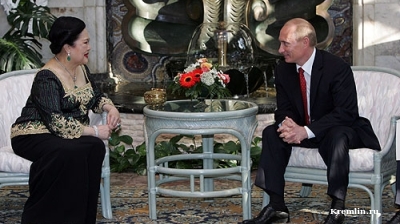Russia’s banking sector has been performing extremely well, but the EU’s decision to impose sanctions on the Central Bank of Russia’s gross international reserves (GIR) on February 27 has upended the sector and could cause a banking crisis.
CBR governor Elvira Nabiullina has spent most of her time since taking over the job in 2013 cleaning up the sector with great results, as it has seen profitability vastly improve in the last few years. But there is one aspect that remains a ticking bomb – the mismatch between banks' currency liabilities and assets.
“The ruble’s plummet – the currency dropped by 30% against the dollar earlier today, although it has since recovered ground – means that there is likely to be a high demand to withdraw foreign currency. A key point in this regard is that while Russian banks have ample ruble liquidity, their liquid foreign currency assets in the form of cash holdings are dwarfed by their short-term foreign currency liabilities,” Liam Peach of Capital Economics said in a note.
Russian banks have some $280bn in the hard currency accounts of its customers (a third of which is retail deposit accounts), but only $46bn of actual dollars in cash to cover those deposits, reports Capital Economics.
“Previously, there had been a widespread assumption that the CBR’s large foreign exchange reserves meant that this shortfall of liquid FX assets wouldn’t be a problem. But Western sanctions on the CBR upend this narrative,” says Capital Economics’ Peach.
If everyone withdraws their dollars at once then banks will simply not have enough cash to cover the demand.
Moreover, the banking business is based on the assumption that deposits will never withdraw more than 8% of their money at any one time, although in emerging markets banks like to keep this “capital adequacy ratio” closer to 20% as their markets are so crisis-prone. That means classically if Russian banks have $280bn of liabilities they need a minimum of $22.4bn in cash to meet the 8% demand, but are well advised to have $78.4bn to have the extra buffer to deal with shocks.
The $48bn of cash they actually have is 17.1% of the total liabilities, which is already a very conservative amount and in normal times a perfectly adequate cash buffer. But these are not normal times.
The size of the shock Russia’s economy has just taken is so great that if there is a general panic then demand to withdraw all the dollars from the banks will spike and could burn through the CBR’s now diminished reserves.
It remains unclear just how much of the CBR’s cash the West can freeze following the new GIR sanctions but the European Union's top diplomat, Josep Borrell, said in comments on February 28 the EU estimates that half of the CBR’s $643bn is exposed, leaving the central bank with $321bn in cash.
If all the dollars were withdrawn then that would leave the banks sort of cash dollars by $232bn. If they turned to the CBR to make up the shortfall the CBR would be left with only $89bn. That is only 2.3 months of import cover, below the three months that economists believe is necessary to ensure the stability of the currency. If the CBR reserves fell this low then a currency crisis would occur and make the situation even worse, as the financial system would go into a death spiral.
So far there is has not been a general run on banks and all the banks’ dollar depositors are not asking for all their money back. So the bank sector is not in danger yet. But the sector is likely to come under very uncomfortable pressure very soon.
In addition to the sanctions on the CBR’s GIR, the EU has also imposed partial SWIFT sanctions designed to do, in EU President Ursula Von der Leyen’s words, “maximum damage” to the financial sector. The state-owned VTB Bank and Sber (formerly known as Sberbank) banking giants, that together control more than half of Russia’s deposits, have both been singled out and excluded from the international payment system.
The dollar liabilities of these two banks account for roughly $140bn of the dollar deposits, of which approximately $46.7bn are retail deposits held in dollars.
And here is the problem. As Sber and VTB can no longer operate in dollars thanks to the SWIFT sanctions you can expect the population to withdraw all their dollar deposits from these two banks. That is an amount equivalent to the entire cash dollar reserves of the entire banking system.
“Reports emerged over the weekend of large queues to withdraw deposits and the risk of runs on banks is only likely to build. A fall in deposits will force banks to sell their liquid assets. Once these have been used up, banks may have to sell other assets – probably at depressed prices. This will cause banks’ balance sheets to shrink, credit conditions to tighten and it could erode banks’ capital positions,” Peach says.
These two banks don't have that much cash dollar money. And that is assuming the corporates withdraw none of their cash dollar money and move it to another bank that is not banned from SWIFT.
Of course a lot of the customers at VTB and Sber are cash-rich state-owned companies that can be ordered to leave their cash with the state-owned behemoths, but if you assume all the retail deposits withdraw their money and half the corporates move their dollars and that the two state-owned banks hold half of the actual dollar cash in the system, then that still means the two banks will be short by around $70bn, which they will have to ask the CBR for.
That will leave the CBR with $251bn of reserves and this is equivalent of six to seven months of import cover – a comfortable level to ensure the stability of the currency.
All this assumes that the dollar withdrawals are just from Sber and VTB and that the corporate demand for dollars is limited. But of course the entire banking sector is affected and as the ruble crashes the population will become increasingly nervous and will want to change their rubles into dollars to protect their savings.
The central bank has already acted decisively on the first day and the CBR imposed an emergency 20% rate hike on February 28 that halted the ruble's free fall past the psychologically important RUB100 to the dollar level; at the time of writing the exchange rate had recovered to RUB99.5 to the dollar, which is still a deeply distressed level and down from the RUB94 it was mid-morning the same day. If the ruble continues to slide then things could quickly spin out of control and CBR has already said in a statement the same morning that it is standing by to “take more action” if needed – restrictions on deposits and currency controls or surrender requirements on exporters earning dollars are waiting in the wings.
Capital Economics says that liquidity on the interbank market is a key element to watch, as while the interbank market is working banks will be able to finance their dollar liquidity mismatches by borrowing from those banks with excess dollars. But if fears of defaults rise and the liquidity on the interbank market dries up, the entire banking sector is in danger and the CBR could be forced to burn through almost all of its much reduced reserves very rapidly, sparking a major financial crisis.
And the banking sector is going to come under renewed pressure from other directions thanks to the meltdown on the financial markets. The very modest bad debt is likely to accelerate sharply thanks to the crashing ruble exchange rate, which makes servicing dollar-denominated debt much more expensive, and the recession the new 20% interest rates is bound to cause will also push non-performing loans (NLPs) up, eating into banking sector profitability.
“The upshot is that policymakers will have to provide significant support to banks. The CBR has broadened collateral requirements and hiked interest rates aggressively. Finance Minister Siluanov has already talked about recapitalisation – the one crumb of comfort here is that Russia’s fiscal position gives it space to do so. Deposit withdrawal limits seem likely, as do other forbearance measures. One key thing to watch now is whether the interbank market freezes, causing interbank rates to shoot up,” Peach concludes.
News

Trump would like to meet North Korea’s Kim Jong Un during Asia trip
The prospect of renewed diplomacy between Washington and Pyongyang has lingered since Kim’s remarks last month suggesting a willingness to speak to the outside world.

Bill Gates makes surprise Indian TV debut
In a move set to spark both intrigue and curiosity, Microsoft co-founder and philanthropist Bill Gates has made a cameo appearance on Indian television, entering the iconic drama series Kyunki Saas Bhi Kabhi Bahu Thi 2.

Queen Sirikit of Thailand dies
The death of Queen Sirikit of Thailand has marked the end of an era for the Thai monarchy. According to an official statement from the Bureau of the Royal Household of Thailand, Her Majesty died at 9.21 pm on October 24.

Pakistan, the latest in Asia to see gold prices plummet
In international trading, the precious metal lost $35 per ounce to settle around $4,115, extending a week-long slide triggered by shifting expectations over US monetary policy.
_1761305900.jpg)



